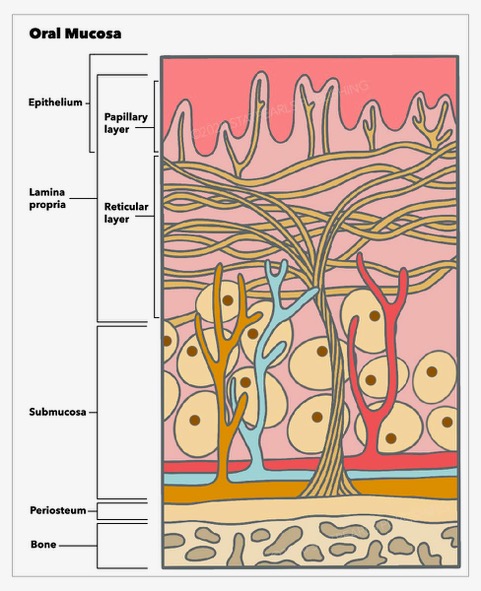[1]
Rivera C. Essentials of oral cancer. International journal of clinical and experimental pathology. 2015:8(9):11884-94
[PubMed PMID: 26617944]
[2]
Gandini S,Botteri E,Iodice S,Boniol M,Lowenfels AB,Maisonneuve P,Boyle P, Tobacco smoking and cancer: a meta-analysis. International journal of cancer. 2008 Jan 1;
[PubMed PMID: 17893872]
Level 1 (high-level) evidence
[3]
Lee YC, Marron M, Benhamou S, Bouchardy C, Ahrens W, Pohlabeln H, Lagiou P, Trichopoulos D, Agudo A, Castellsague X, Bencko V, Holcatova I, Kjaerheim K, Merletti F, Richiardi L, Macfarlane GJ, Macfarlane TV, Talamini R, Barzan L, Canova C, Simonato L, Conway DI, McKinney PA, Lowry RJ, Sneddon L, Znaor A, Healy CM, McCartan BE, Brennan P, Hashibe M. Active and involuntary tobacco smoking and upper aerodigestive tract cancer risks in a multicenter case-control study. Cancer epidemiology, biomarkers & prevention : a publication of the American Association for Cancer Research, cosponsored by the American Society of Preventive Oncology. 2009 Dec:18(12):3353-61. doi: 10.1158/1055-9965.EPI-09-0910. Epub
[PubMed PMID: 19959682]
Level 2 (mid-level) evidence
[4]
Kumar M, Nanavati R, Modi TG, Dobariya C. Oral cancer: Etiology and risk factors: A review. Journal of cancer research and therapeutics. 2016 Apr-Jun:12(2):458-63. doi: 10.4103/0973-1482.186696. Epub
[PubMed PMID: 27461593]
[5]
Jafarey NA, Mahmood Z, Zaidi SH. Habits and dietary pattern of cases of carcinoma of the oral cavity and oropharynx. JPMA. The Journal of the Pakistan Medical Association. 1977 Jun:27(6):340-3
[PubMed PMID: 413946]
Level 3 (low-level) evidence
[6]
Candotto V, Lauritano D, Nardone M, Baggi L, Arcuri C, Gatto R, Gaudio RM, Spadari F, Carinci F. HPV infection in the oral cavity: epidemiology, clinical manifestations and relationship with oral cancer. ORAL & implantology. 2017 Jul-Sep:10(3):209-220. doi: 10.11138/orl/2017.10.3.209. Epub 2017 Nov 30
[PubMed PMID: 29285322]
[7]
Kruse AL, Grätz KW. Oral carcinoma after hematopoietic stem cell transplantation--a new classification based on a literature review over 30 years. Head & neck oncology. 2009 Jul 22:1():29. doi: 10.1186/1758-3284-1-29. Epub 2009 Jul 22
[PubMed PMID: 19624855]
[8]
Bray F, Ferlay J, Soerjomataram I, Siegel RL, Torre LA, Jemal A. Global cancer statistics 2018: GLOBOCAN estimates of incidence and mortality worldwide for 36 cancers in 185 countries. CA: a cancer journal for clinicians. 2018 Nov:68(6):394-424. doi: 10.3322/caac.21492. Epub 2018 Sep 12
[PubMed PMID: 30207593]
[9]
Montero PH, Patel SG. Cancer of the oral cavity. Surgical oncology clinics of North America. 2015 Jul:24(3):491-508. doi: 10.1016/j.soc.2015.03.006. Epub 2015 Apr 15
[PubMed PMID: 25979396]
[10]
Naruse T, Yanamoto S, Matsushita Y, Sakamoto Y, Morishita K, Ohba S, Shiraishi T, Yamada SI, Asahina I, Umeda M. Cetuximab for the treatment of locally advanced and recurrent/metastatic oral cancer: An investigation of distant metastasis. Molecular and clinical oncology. 2016 Aug:5(2):246-252
[PubMed PMID: 27446558]
[11]
Kato MG, Baek CH, Chaturvedi P, Gallagher R, Kowalski LP, Leemans CR, Warnakulasuriya S, Nguyen SA, Day TA. Update on oral and oropharyngeal cancer staging - International perspectives. World journal of otorhinolaryngology - head and neck surgery. 2020 Mar:6(1):66-75. doi: 10.1016/j.wjorl.2019.06.001. Epub 2020 Mar 6
[PubMed PMID: 32426706]
Level 3 (low-level) evidence
[12]
Wang B,Zhang S,Yue K,Wang XD, The recurrence and survival of oral squamous cell carcinoma: a report of 275 cases. Chinese journal of cancer. 2013 Nov;
[PubMed PMID: 23601241]
Level 3 (low-level) evidence
[13]
Renou A, Guizard AV, Chabrillac E, Defossez G, Grosclaude P, Deneuve S, Vergez S, Lapotre-Ledoux B, Plouvier SD, Dupret-Bories A, Francim Network. Evolution of the Incidence of Oral Cavity Cancers in the Elderly from 1990 to 2018. Journal of clinical medicine. 2023 Jan 30:12(3):. doi: 10.3390/jcm12031071. Epub 2023 Jan 30
[PubMed PMID: 36769722]
[14]
Uguru CC, Chukwubuzor O, Otakhoigbogie U, Ogu UU, Uguru NP. Awareness and knowledge of risk factors associated with oral cancer among military personnel in Nigeria. Nigerian journal of clinical practice. 2023 Jan:26(1):73-80. doi: 10.4103/njcp.njcp_322_22. Epub
[PubMed PMID: 36751827]
[15]
Rochefort J, Karagiannidis I, Baillou C, Belin L, Guillot-Delost M, Macedo R, Le Moignic A, Mateo V, Soussan P, Brocheriou I, Teillaud JL, Dieu-Nosjean MC, Bertolus C, Lemoine FM, Lescaille G. Defining biomarkers in oral cancer according to smoking and drinking status. Frontiers in oncology. 2022:12():1068979. doi: 10.3389/fonc.2022.1068979. Epub 2023 Jan 11
[PubMed PMID: 36713516]
[16]
Ferrándiz-Pulido C, Leiter U, Harwood C, Proby CM, Guthoff M, Scheel CH, Westhoff TH, Bouwes Bavinck JN, Meyer T, Nägeli MC, Del Marmol V, Lebbé C, Geusau A. Immune Checkpoint Inhibitors in Solid Organ Transplant Recipients With Advanced Skin Cancers-Emerging Strategies for Clinical Management. Transplantation. 2023 Jul 1:107(7):1452-1462. doi: 10.1097/TP.0000000000004459. Epub 2023 Jun 20
[PubMed PMID: 36706163]
[17]
Tsai CY, Wen YW, Lee SR, Ng SH, Kang CJ, Lee LY, Hsueh C, Lin CY, Fan KH, Wang HM, Hsieh CH, Yeh CH, Lin CH, Tsao CK, Fang TJ, Huang SF, Lee LA, Fang KH, Wang YC, Lin WN, Hsin LJ, Yen TC, Cheng NM, Liao CT. Early relapse is an adverse prognostic factor for survival outcomes in patients with oral cavity squamous cell carcinoma: results from a nationwide registry study. BMC cancer. 2023 Feb 7:23(1):126. doi: 10.1186/s12885-023-10602-1. Epub 2023 Feb 7
[PubMed PMID: 36750965]
[18]
Noel CW, Sutradhar R, Chan WC, Fu R, Philteos J, Forner D, Irish JC, Vigod S, Isenberg-Grzeda E, Coburn NG, Hallet J, Eskander A. Gaps in Depression Symptom Management for Patients With Head and Neck Cancer. The Laryngoscope. 2023 Feb 7:():. doi: 10.1002/lary.30595. Epub 2023 Feb 7
[PubMed PMID: 36748910]

